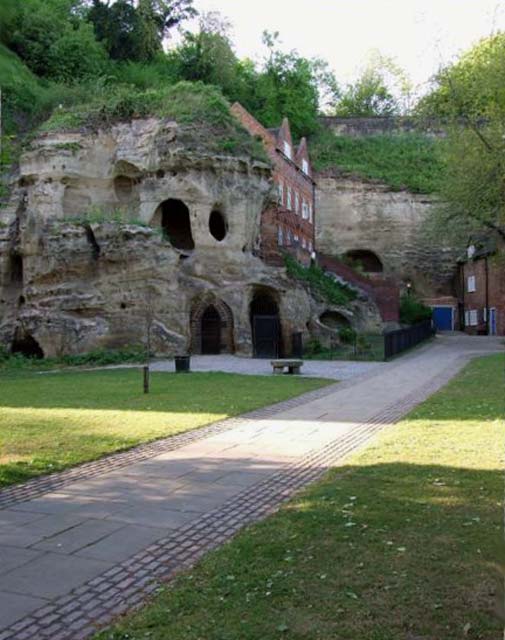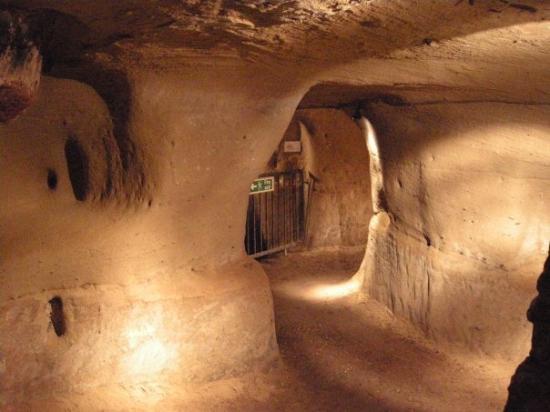Something a little lighter than our usual fare... an enjoyable visit to a mysterious place. I should probably start a blog for this kind of stuff, but nobody would read it, so it's getting put here instead.

This is Gilmerton, which since the 13th century has been an unremarkable little mining town on the outskirts of Edinburgh, Scotland. The mines are closed now - the last one ceased operating as late as the 1960s - and the town itself has long since been absorbed into the city proper and become a suburb like hundreds of others.

There's not a lot to do here. You can't blame folk for turning to the bookies' for a bit of excitement. Shamble down to Ladbrokes, put some money on a horse, and win big... or just spend the days losing heavily like everyone else.

This Ladbrokes is a bit more exciting than most though...
For if you go through to what was once a bathroom fitter's storeroom at the rear of the shop, and descend through a roughly broken hole in the concrete floor, you'll find yourself unexpectedly on a carved and gently curving stone staircase, which leads down to...

Gilmerton Cove itself.




This short video gives an idea of the extent of the passageways, and the difficulties their creators would have faced while building them.
http://www.youtube.com/watch?v=QtVxVEda ... e=youtu.be



A big "G". Yep. A big G. The graffiti is said by experts to be at least a century old, but to be honest I'm not convinced of that. I think some of it might be much more recent.







A square and compass symbol, possibly an inverted cross(?), and a large "punch bowl" carved out of the sandstone table.

There are other symbols, possibly even some writing, but it's hard to make out. Is there a D, a T, and an F in front of the Masonic compass? Not sure.

The letters B R and two other faint square and compasses...
Someone said there is a carving of a cat on the table as well, suggesting a witches' coven met here, but that's just too painfully traditionalist for me and I couldn't see it anyway.
The origin of these chambers, who carved them, the era in which they were actually carved, and the uses they were put to are all unknown.
Gilmerton locals knew about them long before the "experts" did, though, so whether they added any of the Masonic carving and initials themselves in more recent times (either because they were Masons, or just for a laugh) is hard to tell. They certainly used to hang out down here, seeing the place as little more than an interesting remnant of the town's long mining history - which it well might be, in fact, though that wouldn't explain the "furniture" or the elaborateness of the "rooms".

The last known use of the Cove was as a storage space. A local bathroom fitting business found it under their shop floor and made use of the extra room. When the archaeologists first descended into the darkness they found the place full of enamel sinks, baths, toilets and pipes.
Something that doesn't come across in either the pictures or the video is the sheer gloom of the place, and the smell of it. Since the pics were taken with a flash it looks as though the tunnels are bright and easily navigable. They're not. Here's one taken without flash, but I had to brighten it up a bit just to make the outlines of the walls visible at all, otherwise it would just be pitch black. Everyone who was down there with me spent the whole time stumbling around and banging their heads off the ceilings, shouting "shit!" and "fuck's sake!" while the tour guide longsufferingly attempted to tell us about the Cove's history.

The smell is strong too, but not overpowering - it's like the smell of something that's been dead and rotting so long that it's odour has become almost neutral, but can still be recognised instantly as unpleasant. Musty, earthy, fungal - a bit like... well, bit like musty earth with fungus growing in it.
It's very cramped too. The seats have ridiculously inadequate legroom. People were generally a lot shorter back in the day, as you can see from any suit of armour made more than two hundred years ago, so maybe the proportions suited them better at the time than they fit us now. The Bagginses' of Bag End would've felt right at home here.
Needless to say there are innumerable theories as to who built the Cove (it's nowhere near the sea, btw, and certainly doesn't open onto a beach or inlet at any point, so smugglers might have used it as a storage place at some point, but they definitely didn't offload stuff directly from ships to the Cove unless they were prepared to cart it a long way uphill beforehand).
The last person known to haved used the Cove as a dwelling place was a blacksmith called George Patterson, who lived there with his family in the 18th century. Parish records show he was reprimanded for allowing alcohol to be consumed inside the Cove on the Sabbath, which reinforces the theory that it was used mainly as an illegal distillery and drinking den, or "shebeen" as they called them. Patterson claimed to have built the Cove himself, over five years of work, but that's very unlikely. It's much more reasonable to assume he just stumbled across it one day, and since it was under his land he assumed property rights over it (it was situated below the stables he once worked out of).
By the standards of worker's housing in Edinburgh at the time the Cove would've been considered pretty bijou and luxurious - much of the city resembled the infamous Five Points district of New York, and overcrowding among the poor was at hellish levels. At least by living in the Cove Patterson and his family would've been able to avoid sharing the space with multiple other families and legions of intinerant workmen. By living in an underground home Patterson would've also been able to avoid paying the notorious "Window Tax" - from whence the phrase "daylight robbery" originates.
The theories of who inhabited the Cove before and after Patterson range from the semi-reasonable to the outright ridiculous, with the inevitable (and highly unlikely) inclusion of the Templar Knights as one-time residents. It is suggested (sigh) that they hid the Holy Grail here. There's barely anywhere in Scotland that those pricks aren't said to have hid the Holy Grail, though.
Another short vid about all the various theorised inhabitants of the Cove - George Patterson, the Hellfire Club, Masons, Covenanters, Templar Knights (who would've had no reason whatsoever to hide in a hole, since they were never outlawed in Scotland).
http://www.youtube.com/watch?v=WV02O90_ ... e=youtu.be
The bit about Rosslyn Chapel is just...

If it's already a big deal that the passageways stretch a thousand feet through solid stone then don't go making the claim that they stretch another five miles, much of it downhill, then up again, to Rosslyn, as if it was a reasonable hypothesis. FFS. I must admit that rumours of underground passages and chambers are connected to nearly every site the Templars ever visitted or became associated with, though, and it can't all just be smoke without fire. In this case I believe it is though.
Oh, as for the ghost, well... Ghost Finders Scotland (yes, indeed) an award-winning paranormal investigation team
(:shrug: ) did an overnight sit-in at the Cove, and apparently recorded some Electronic Voice Phenomenon. One of the sound files is actually quite decent - a Ghost Finder asks what is behind the rubble blocking the sealed passage, and is 'answered' with the 'words': "Never...mind... Never...mind."
Presumably the ghost (thought to be that of the blacksmith George Patterson) likes Nirvana.
The sound file can be heard here: http://www.ghostfinders.co.uk/gilmerton ... _file2.wav
The other (not very good) EVP files are on this page: http://www.ghostfinders.co.uk/edinburgh ... sults.html














 But certainly nothing like Gilmerton Cove. Regarding ghosts, I know some of the old buildings in Toronto that remain do reportedly contain lost spirits, specifically the building that now serves as the Hockey Hall of Fame comes to mind as one of Toronto's haunted...
But certainly nothing like Gilmerton Cove. Regarding ghosts, I know some of the old buildings in Toronto that remain do reportedly contain lost spirits, specifically the building that now serves as the Hockey Hall of Fame comes to mind as one of Toronto's haunted...